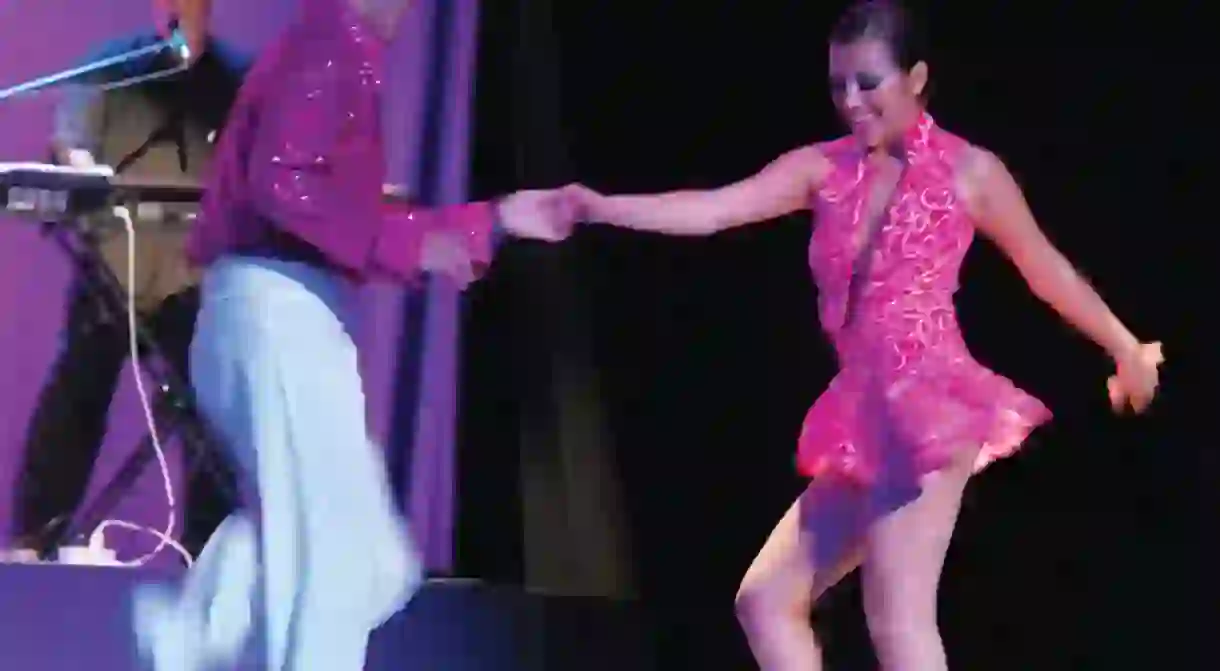Puerto Rican Dances You Need to Know

Watching a Puerto Rican couple on the dance floor is a glorious display as their bodies glide as one to the hot beat of salsa, but while salsa was originated by Puerto Ricans in New York and is the most popular dance, there are others that are just as dazzling.
Salsa
It is not clear who coined the term “salsa” for this style of dancing, but perhaps it is because it is a blend of many of the dances of Puerto Rico: plena, bomba, cha-cha and mambo, a saucy mixture of a Caribbean sound with a Cuban beat. The dance itself was developed in the mid-’70s by Puerto Ricans in New York. It is believed that the popularity of disco at the time also influenced this dance, as you see glimpses of the Latin Hustle. Salsa is a combination of fast footwork and swaying hips, while the upper body maintains its position. The turns the couple make is what differentiates salsa from mambo.
Merengue
Merengue is the national dance of the Dominican Republic where it was developed in the late 1700s and came to prominence in the 1800s. It is considered the simplest of the Latin dances to learn as it has relatively easy side-to-side movement, with the man stepping to his left in the “chase step,” and then “dragging” the right leg to meet the left leg. There are differing stories as to how this leg drag came about. One story is that a man with a wooden leg, perhaps a pirate, would dance on the beach to the merengue music, thus dragging his wooden right leg. Another description of the dance step is that it came from the slaves who were chained together by the ankle, thereby creating the necessity of having to drag the right foot. While it may not be as complicated as salsa, the fast beat and staccato horns keep dancers moving.
Danza
Danza is a more rigid dance revealing a European influence that has very specific movements and patterns. A lead dancer, usually the best most experienced dancer, dictated the movements and the other dancers followed. There was also a conductor, of sorts, who determined how many dancers there would be for each song. This was around the turn of the 19th century, but in the mid-1800s, an influx of Cuban immigrants brought a new spark to the dance and from that came danza. It is now less structured than the original version.
Plena
La Plena began on the southern coast of Puerto Rico, and today is very popular in places like Ponce. The music of plena has a heavy African influence, the instruments being primarily drums and percussion. It is accurately described by the phrase “el periodico contada,” as each song is a living newspaper that tells the story of the working class. When plena is being played, there are no lyrics, but there may be instrumental solos.
Bomba
Bomba is another music style and dance that came from the slaves in the sugar cane fields of Puerto Rico. Because of this you again hear the influence of Africa in the drums, but in bomba Spanish music is also combined with the music of the Taino culture. A striking difference between bomba and plena is that in bomba, the drummer follows the dancer, rather than the usual practice of the dancer following the musicians. Bomba also tells a story, usually with a lead singer supplying the verses, and everyone else singing the “chorus.” Also in bomba, there will be a pause in the music as people take turns adding a verse, again providing a glimpse of daily life of Puerto Rico.
Cha-Cha
Compared to bomba, plena and danza, cha-cha is pretty much a newcomer. It was originated in Cuba in the 1950s by composer Enrique Jorrin, who developed the music by the same name. The name of this dance comes from the sound the shoes make on the dance floor. The cha-cha is a spinoff of mambo, the Latin dance of Cuba. In today’s competitions, the dance has become more of a blend of salsa and cha-cha.













